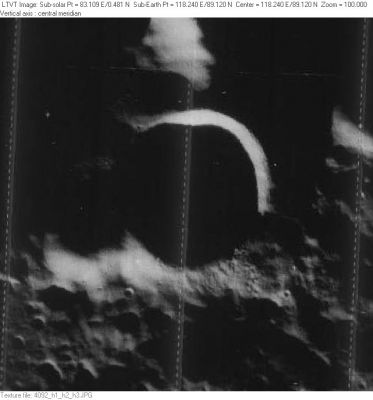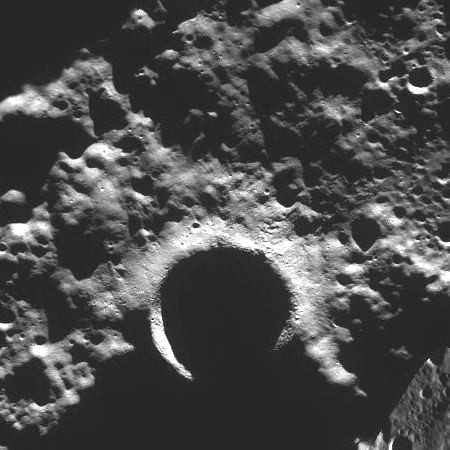Whipple
Contents
Whipple (north pole crater)
| Lat: 89.12°N, Long: 118.24°E, Diam: 15.7 km, Depth: km, Rükl: (farside) |
Table of Contents
[#Whipple (north pole crater) Whipple (north pole crater)]
[#Whipple (north pole crater)-Images Images]
[#Whipple (north pole crater)-Maps Maps]
[#Whipple (north pole crater)-Description Description]
[#Whipple (north pole crater)-Description: Wikipedia Description: Wikipedia]
[#Whipple (north pole crater)-Additional Information Additional Information]
[#Whipple (north pole crater)-Nomenclature Nomenclature]
[#Whipple (north pole crater)-LPOD Articles LPOD Articles]
[#Whipple (north pole crater)-Bibliography Bibliography]


left: Lunar Orbiter IV In this aerial view from space, Whipple is the large, shadowed crater in the center; on the rim of the much larger [/Peary Peary]. The Moon's [/north%20pole north pole] is about a crater width outside the field at the top. [/Peary Peary], and the direction towards Earth, are to the left.
right: LROC . North Pole close to bottom left corner; Peary floor at bottom right
Images
LPOD Photo Gallery Lunar Orbiter Images
Maps
([/LAC%20zone LAC zone] 1A2) USGS Digital Atlas PDF Lunar Orbiter version
Description
Description: Wikipedia
Additional Information
- Whipple is the IAU-named crater whose center is second closest to the Moon's [/north%20pole north pole]. [/Hinshelwood Hinshelwood] is closer.
- Whipple is a control point in the [/ULCN#ULCN_1994 1994 ULCN], where it is known as G1001.
- Although its interior is constantly in shadow, and it is technically a "farside" crater, during the waxing phase of the lunation, especially between [/phases First Quarter] and [/Full%20Moon Full Moon], Whipple can be fairly easily spotted on photos of the Moon's north pole taken from Earth when a strong positive [/librations libration] in latitude combines with the Sun being north of the Moon's equator. Under such circumstances, the neighboring crater [/Peary Peary] has a diamond-shaped appearance, and the sunlit rim of Whipple can be seen as a small oval at the apex of the diamond. After Full Moon, Whipple fades and the nearby crater [/Hinshelwood Hinshelwood], on the opposite side of the pole, becomes visible.
Nomenclature
- Named for Fred Lawrence Whipple (1906-2004), an American astronomer noted especially for his interest in comets and meteors.
- New name approved by the IAU on April 17, 2009.
- It might be interesting to include John Adams Whipple (1822-1891), American inventor and early photographer of the moon (mentioned in the book Epic Moon by Sheehan and Dobbins).- DannyCaes DannyCaes Jun 6, 2014
- This name (the north pole's Whipple) is not related to Mount Whipple (a cluster of hillocks in Mare Imbrium, west-northwest of La Hire, also called La Hire Alpha). Mount Whipple was one of H.P.Wilkins's proposed names.- DannyCaes DannyCaes Apr 18, 2009
LPOD Articles
Bibliography
This page has been edited 1 times. The last modification was made by - tychocrater tychocrater on Jun 13, 2009 3:24 pm - afx4